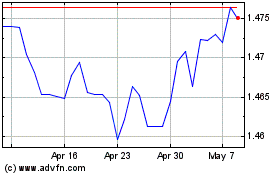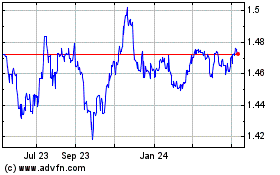Antipodean Currencies Fall After China Services PMI Slips To 6-month Low
April 05 2017 - 10:42PM
RTTF2
Antipodean currencies such as the Australian, the New Zealand
and the Canadian dollars weakened against their major counterparts
in the Asian session on Thursday, after data showed that the
services sector in China continued to expand in March, although at
a slower pace in 6-months.
Data from Caixin showed that the services sector in China
continued to expand in March, although at a slower pace, with a PMI
score of 52.2. That's down from 52.6 in February. ?Also, the
composite PMI fell to 52.1 from 52.6 in February.
Meanwhile, Asian stock markets are in negative territory
following the overnight losses on Wall Street after the latest FOMC
meeting minutes revealed that the Federal Reserve is ready to start
shrinking its bloated $4.5 trillion balance sheet this year.
Investors are also looking forward to the highly-anticipated
meeting between President Trump and Chinese President Xi Jinping
later today.
Crude oil delivery for May is currently down by 0.11 percent or
$51.04 per barrel. Crude oil futures eased from one-month highs
after a surprising build in U.S. oil inventories.
The Energy Information Administration said inventories rose by
1.6 million barrels. That's in contrast to an industry report from
the American Petroleum Institute showing a 1.8 million barrel
decline.
In the Asian trading, the Australian dollar fell to a 9-day low
of 1.4171 against the euro and nearly a 4-1/2-month low of 83.15
against the yen, from yesterday's closing quotes of 1.4088 and
83.77, respectively. If the aussie extends its downtrend, it is
likely to find support around 1.43 against the euro and 82.00
against the yen.
Against the U.S., the Canadian and the New Zealand dollars, the
aussie dropped to nearly a 4-week low of 0.7533, a 3-day low of
1.0126 and a 2-day low of 1.0813 from yesterday's closing quotes of
0.7566, 1.0169 and 1.0865, respectively. The aussie may test
support near 0.73 against the greenback, 1.00 against the loonie
and 1.06 against the kiwi.
The NZ dollar fell to nearly a 5-month low of 76.86 against the
yen, from yesterday's closing value of 77.07. The kiwi may test
support near the 75.00 region.
Against the U.S. dollar, the kiwi edged down to 0.6960 from an
early 2-day high of 0.6985. On the downside, 0.68 is seen as the
next resistance level for the greenback.
The kiwi dropped to a 1-week low of 1.5337 against the euro,
from an early 2-day high of 1.5277 . If the kiwi extends its
downtrend, it is likely to find support around the1.55 area.
The Canadian dollar fell to an 8-day low of 1.4356 against the
euro, from yesterday's closing value of 1.4328. The loonie is
likely to find support near the 1.45 region.
Against the U.S. dollar and the yen, the loonie dropped to 2-day
lows of 1.3444 and 82.08 from yesterday's closing quotes of 1.3437
and 82.36, respectively. If the loonie extends its downtrend, it is
likely to find support around 1.36 against the greenback and 81.00
against the yen.
Looking ahead, Eurozone retail PMI for March is due to to be
released later in the day.
At 7:45 am ET, European Central Bank Executive Board Member
Vitor Constancio is expected to speak at Eurofi High Level Seminar
2017 in Malta.
In the New York session, European Central Bank's minutes of the
latest monetary policy meeting, Canada building permits for
February and U.S. weekly jobless claims for the week ended April 1
are slated for release.
Euro vs CAD (FX:EURCAD)
Forex Chart
From Mar 2024 to Apr 2024

Euro vs CAD (FX:EURCAD)
Forex Chart
From Apr 2023 to Apr 2024
